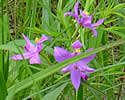Calopogon oklahomensis (Oklahoma Grass-pink)
| Also known as: | |
|---|---|
| Genus: | Calopogon |
| Family: | Orchidaceae (Orchid) |
| Life cycle: | perennial |
| Origin: | native |
| Habitat: | part shade, sun; dry to mesic prairie, open woods |
| Bloom season: | June - July |
| Plant height: | 4 to 14 inches |
| Wetland Indicator Status: | none |
| MN county distribution (click map to enlarge): |  |
| National distribution (click map to enlarge): |  |
Pick an image for a larger view. See the glossary for icon descriptions.
Detailed Information
Flower: 

![[photo of flowers]](/udata/r9ndp23q/contrib/calopogon-ok-DSC_0888-t.jpg) A bright cluster of 2 to 7 pale to deep pink (rarely white) flowers 1 to 1½ inches across, widely spaced and opening simultaneously in a raceme at tip of smooth, slender stalk. Flowers are irregular, 6-parted and atypical to most orchid species, the lip - a modified petal - is situated at the top of the flower rather than the bottom. The lip is fiddle shaped with an inflated tip, somewhat rounded triangular with a cluster of long, yellow tipped, stamen-like bristles at the constriction point between the tip and neck below. Above this bristly tip is a triangular area on the lip covered in short, stout, pink bristles. The lip is flanked by two broadly, lance oval sepals, then a pair of somewhat smaller lance-elliptic petals with another single lance-elliptic sepal below. The center column curves down and out just above the lower sepal, the stigma embedded at the tip between two flaring flat, rounded lobes (rostellum).
A bright cluster of 2 to 7 pale to deep pink (rarely white) flowers 1 to 1½ inches across, widely spaced and opening simultaneously in a raceme at tip of smooth, slender stalk. Flowers are irregular, 6-parted and atypical to most orchid species, the lip - a modified petal - is situated at the top of the flower rather than the bottom. The lip is fiddle shaped with an inflated tip, somewhat rounded triangular with a cluster of long, yellow tipped, stamen-like bristles at the constriction point between the tip and neck below. Above this bristly tip is a triangular area on the lip covered in short, stout, pink bristles. The lip is flanked by two broadly, lance oval sepals, then a pair of somewhat smaller lance-elliptic petals with another single lance-elliptic sepal below. The center column curves down and out just above the lower sepal, the stigma embedded at the tip between two flaring flat, rounded lobes (rostellum).
Leaves and stems: 

![[photo of leaf]](/udata/r9ndp23q/contrib/calopogon-ok-DSC_0879-t.jpg) The single leaf is very long and linear, grass-like, 2¾ to 13½ inches long and typically between ¼ to just over ½ inch wide, the leaf often as long as or longer than the flowering stem.
The single leaf is very long and linear, grass-like, 2¾ to 13½ inches long and typically between ¼ to just over ½ inch wide, the leaf often as long as or longer than the flowering stem.
Notes:
Oklahoma Grass-pink was recognized as a new species only recently, in 1994. Initially its range was considered restricted to south central US, but subsequent herbarium investigations expanded that range into the Upper Midwest, including Minnesota. According to Welby Smith's book “Native Orchids of Minnesota”, the most recent MN specimen dates back to 1884, and while verification via specimens 130 years or older leaves some room for doubt, it is more than less accepted as native to the state but likely long extinct. While the enigma of extinction diminishes the likelihood of new modern discoveries, such events do occur with some frequency for numbers of species and would certainly be an exciting discovery for a lucky field botanist and a great pleasure for the rest of us. Very similar to Tuberous Grass-pink (Calopogon tuberosa) with which it was once lumped, it can be identified in the field.
The first characteristic would be habitat, likely upland mesic prairie to drier oak savannas in our southeastern counties as compared to the wet swamps and bogs of central and northern counties where C. tuberosa occurs. C. tuberosa is generally a larger plant with flowers that open in sequence over a few weeks, where C. oklahomenesis is overall smaller with flowers all opening about the same time. Another characteristic of C. oklahomenesis is a longer leaf that typically reaches up into the flower cluster where C. tuberosa flowers typically rise well above the leaf. Both species have the modified petal that is the upper lip with a cluster of bright yellow, stamen like bristles near the tip. But in C. oklahomensis, the lip is more fiddle-shaped and about as long as wide, where C. tuberosus is considered more anvil-shaped, the inflated tip wider than long. Above the cluster of long yellow bristles found in both species is a second cluster of shorter bristles in the center of lip. In C. oklahomensis these shorter bristles are pink and cover a triangular area that nearly reaches the tip. In C. tuberosa, the short bristles cover a small circular area and are white, often tipped with deep yellow to orange like the longer bristles just below them. See NatureServe for additional information and characteristics about this species.
Native Plant Nurseries, Restoration and Landscaping Services ↓
More photos
Photos courtesy Christopher David Benda taken in Illinois.
Comments
Have you seen this plant in Minnesota, or have any other comments about it?
on: 2014-01-18 22:35:01
What a stunning flower! The images are very nice. It would have been quite the treat to have seen it MN.
on: 2014-01-19 10:50:49
We've had a bit of luck stumbling upon other species thought to be extinct in MN, perhaps we'll happen upon this one sometime, too. :-)







 Oklahoma Grass-pink plant
Oklahoma Grass-pink plant plants in habitat
plants in habitat broader habitat
broader habitat Oklahoma vs. Tuberous Grass-pink
Oklahoma vs. Tuberous Grass-pink